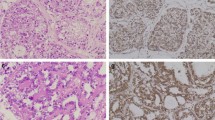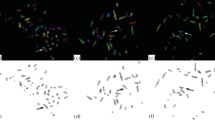Summary
The cell line 5637 which originated from a human urinary bladder carcinoma is known to produce GM-CSF and Multi-CSF ectopically. Determination of cell surface antigens defined by monoclonal antibodies was recently reported [6]. Here we report on the ultrastructure and karyology of this CSF secreting cell line. At the ultrastructural level the monolayer in vitro culture and the solid tumors formed in nude mice showed all characteristics consistent with a well-differentiated transitional cell carcinoma (TCC). A subclone was found to grow in suspension and did not secrete any CSF activity. High resolution chromsome analysis revealed chromosomal abnormalities which agreed only in few particulars with nonrandom chromosomal aberrations usually found in TCC. Analysis of the cytogenetic results showed that nearly all structural abnormalities present are known to be associated with acute or chronic human leukemia. The possibility that the ectopic production of CSF in this cell line may be correlated to one or more of the described chromosomal aberrations is discussed.
Similar content being viewed by others
References
Andreef M, Bressler J, Higgins P (1985) Onkogene und Krebs: Übersicht und neue Methode zur Messung der Genexpression in Abhängigkeit vom Zellzyklus. Dtsch Med Wochenschr 110: 30–35
Bartram CR (1984) Oncogenes: Clues to carcinogenesis. Eur J Pediatr 141: 134–142
Burgess AW, Wilson EMA, Metcalf D (1977) Stimulation by human placental conditioned medium of hematopoietic colony formation by human marrow cells. Blood 49: 573–583
Di Persio JF, Brennan JK, Lichtman MA, Speiser BL (1978) Human cell lines that elaborate colony-stimulating activity for the marrow cells of man and other species. Blood 51: 507–519
Fogh J (1978) Cultivation, characterization, and identification of human tumor cells with emphasis on kidney, testis, and bladder tumors. Natl Cancer Inst Monogr 49: 5–9
Fradet Y, Cordon-Cardo C, Thomson T, Daly ME, Whitmore WF, Lloyd KO, Melamed M, Old LJ (1984) Cell surface antigens of human bladder cancer defined by mouse monoclonal antibodies. Proc Natl Acad Sci USA 81: 224–228
Fulker MJ, Cooper EH, Tanaka T (1971) Proliferation and ultrastructure of papillary transitional cell carcinoma of the human bladder. Cancer 27: 71–82
Gibas Z, Prout G, Connolly JG, Pontes JE, Sandberg AA (1984) Nonrandom chromosomal changes in transitional cell carcinoma of the bladder. Cancer Res 44: 1257–1264
Golde DW, Quan SG, Cline MJ (1978) Human T lymphocyte cell line producing colony-stimulating activity. Blood 52: 1068–1072
Hastings RJ, Franks LM (1981) Chromosome pattern, growth in agar and tumorigenicity in nude mice of four human bladder carcinoma cell lines. Br J Cancer 27: 15–21
Koss LG (1977) Some ultrastructural aspects of experimental and human carcinoma of the bladder. Cancer Res 37: 2824–2835
Myers CD, Katz FE, Joshi G, Millar JL (1984) A cell line secreting stimulating factors for CFU-GEMM culture. Blood 64: 152–155
Okabe T, Nomura H, Oshawa N (1982) Establishment and characterization of a human colony-stimulating factor-producing cell line from a squamous cell carcinoma of the thyroid gland. J Natl Cancer Inst 69: 1235–1241
O'Toole C, Price ZH, Ohnuki Y, Unsgaard B (1978) Ultrastructure, karyology and immunology of a cell line originated from a human transitional-cell carcinoma. Br J Cancer 38: 64
Pareda LF, Tabin CJ, Shih C, Weinberg RA (1982) Human EJ bladder carcinoma oncogene is homologue of Harvey sarcoma virus rasgene. Nature 297: 474–478
Pflüger KH, Kapmeyer H, Stach D, Gropp C, Havemann K (1984) Incidence of secretion and characterization of colony-stimulating factor (CSF) in supernatants of tumor cell lines. International Symposium on Peptide Hormones in Lung Cancer, Marburg, June 18–20 (Abstract 8)
Pflüger KH, Kapmeyer H, Stach D, Gassel WD, Havemann K (1984) A cell line from a human carcinoma of the urinary bladder producing a colony-stimulating factor (CSF). Lymphokine Res 3: 265
Pflüger KH, Kapmeyer H, Stach D, Gassel WD, Havemann K (1984) Purification and characterization of a colony-stimulating factor (CSF) produced by a cell line from a human carcinoma of the urinary bladder (UBC). Immunobiology 168: 36
Pike BL, Robinson WA (1970) Human bone marrow colony growth in agar gel. J Cell Physiol 76: 77–84
Price GB, Senn JS, McCulloch EA, Till JE (1975) The isolation and properties of granulocytic colony-stimulating activities from medium conditioned by human peripheral leukocytes. Biochem J 148: 209–217
Quesenberry P, Gimbrone MA (1980) Vascular endothelium as a regulatory of granulopoiesis: production of colony-stimulating activity by cultures human endothelial cells. Blood 56: 1060–1067
Reddy EP, Reynolds RK, Santos E, Barbacid M (1982) A point mutation is responsible for the aquisitation of transforming properties by the T 24 human bladder carcinoma oncogene. Nature 300: 149–152
Rowley JD (1982) Identification of the constant chromosome regions involved in human hematologic malignant disease. Science 216: 749–751
Sato N, Asano S, Ueyama Y, Mori M, Okabe T, Kondo N, Ohsawa N, Kosaka K (1979) Granulocytosis and colony-stimulating activity (CDSA) produced by a human squamous cell carcinoma. Cancer 43: 605–610
Shah RG, Caporale HH, Moore MSA (1977) Characterization of colony-stimulating activity produced by human monocytes and phytohemagglutinin-stimulated lymphocytes. Blood 50: 811–821
Sparkes RS (1984) Cytogenetics of leukemia. N Engl J Med 311: 848–850
Svet-Moldavsky GJ, Zinzar SN, Svet-Moldavskaya IA, Mann PE, Holland JF, Fogh J, Arlin Z, Clakson BD (1983) CSF-producing human tumor cell lines. Lack of CSF-activity of human stromal bone marrow fibroblasts. Exp Hematol 8: 76
Weiss RA, Marshall CJ (1984) Oncogenes. Lancet 2: 1138–1142
Welte K, Platzer E, Lu L, Gabrilove J, Levi E, Polivka A, Mertelsmann R, Moore MAS (1984) Purification and biochemical characterization of human pluripotent hematopoietic colony-stimulating factor produced by a human bladder carcinoma cell line. Lymphokine Res 3: 281
Wu MC, Cini JK, Yunis AA (1979) Purification of a colony-stimulating factor from cultured pancreatic carcinoma cells. J Biol Chem 245: 6226–6228
Yunis JJ (1983) The chromosomal basis of human neoplasia. Science 221: 227–236
Author information
Authors and Affiliations
Rights and permissions
About this article
Cite this article
Pflüger, K.H., Probeck, H.D., Adler, G. et al. Karyotype and ultrastructure of a colony stimulating factor (CSF) producing cell line (5637) originated from a carcinoma of the human urinary bladder. Blut 53, 89–100 (1986). https://doi.org/10.1007/BF00321091
Received:
Accepted:
Issue Date:
DOI: https://doi.org/10.1007/BF00321091




